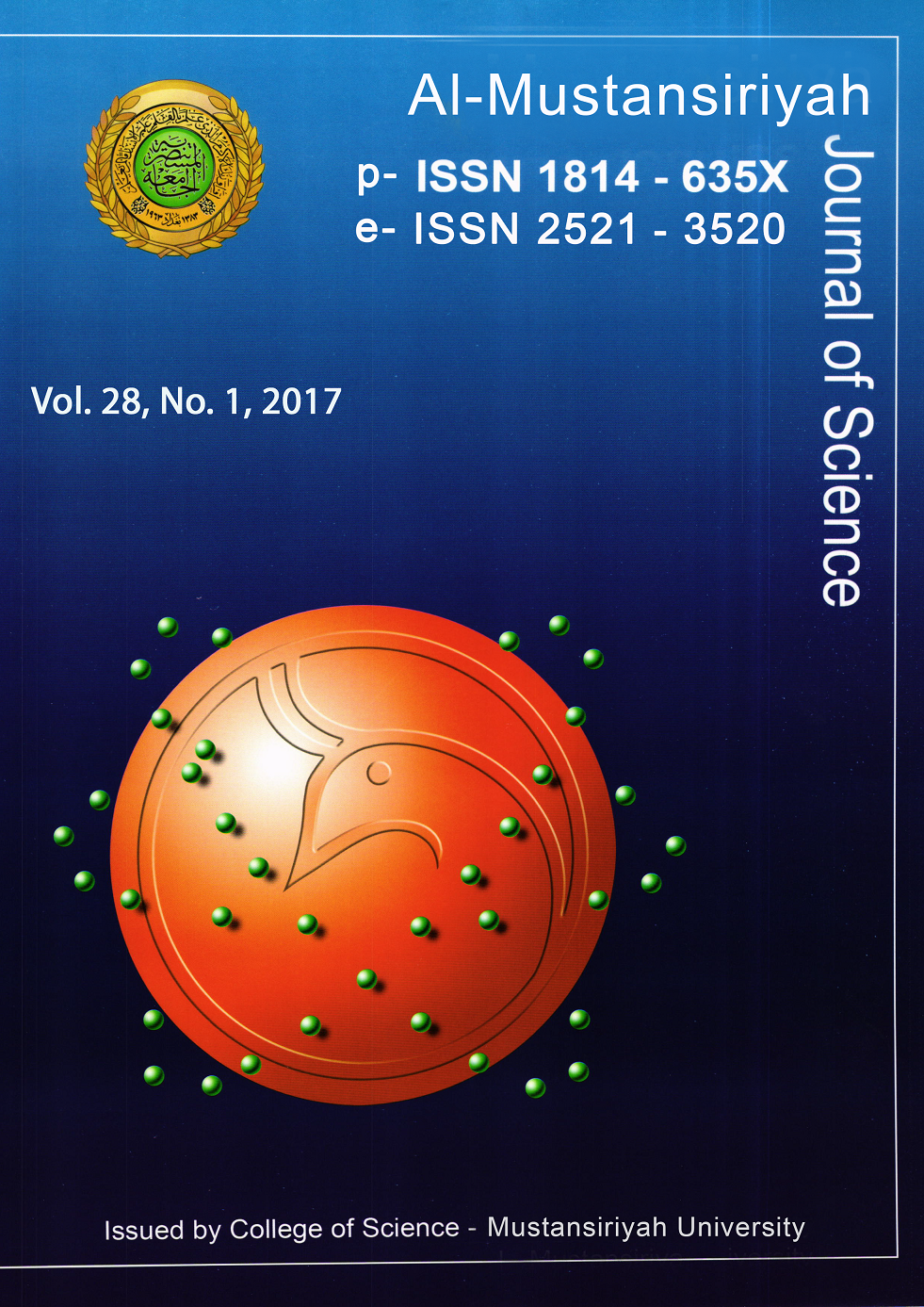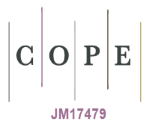Antimicrobial Resistance Patterns and Extended Spectrum Beta-lactamases Producing by Proteus mirabilis Isolated from Different Sources
DOI:
https://doi.org/10.23851/mjs.v28i1.311Keywords:
Proteus mirabilis, antibiotic, extended-spectrum β-lactamse.Abstract
A total of 801 samples included 179 clinical samples and 622 animal samples were collected from Baghdad province. All samples were cultured on blood agar and MacConkey agar plates to isolate proteus mirabilis bacteria. Results showed that rate isolates of P. mirabilis from clinical and animal samples were 25.89% (51/179) and 5.95% (37/622) respectively. Antibiotic susceptibility test showed that lowest resistance rates for clinical P. mirabilis isolates were 3.9% for ciprofloxacin, 7.8% for norfloxacin, 9.8% for imipenem, 13.7% for levofloxacin and 15.7% for cefotaxime, and highest resistance rates were 82.4% for cefepime, 78.4% for piperacillin, 56.9% for ceftazidime and 54.9% for cefoxitin. In regards to animal isolates, they were 100% sensitive to cefoxitin and 100% resistance to piperacillin. Their resistance rates were 2.7% to amikacin, 5.4% to ciprofloxacin and 8.1% to cefepime, imipenem and levofloxacin. The results revealed that all P. mirabilis isolates were 100% multidrug resistance for 2-8 antibiotics. Extended spectrum β-lactamases produced were detected in 52.94% of clinical P. mirabilis isolates and in 48.65% of animal isolates.Downloads
References
Levinson, W., Review of Medical Microbiology and Immunology. 13th ed. McGraw-Hill Education, USA, 2014.
Jacobsen, S. M.; Sticker, D. J.; Mobley, H. L. T. and Shirtliff, M. E., Complicated catheter-associated urinary tract infections due to Escherichia coli and Proteus mirabilis. Clin Microbiol Review, 21 (1): 26-59, 2008. CrossRef
Himps, S. D.; Lockatell, C. V.; Hebel, J. R.; Johnson, D. E. and Mobley1, L. T., Identification of virulence determinants in uropathogenic Proteus mirabilis using signature-tagged mutagenesis. J. Med. Microbiol., 57: 1068–1078, 2008. CrossRef
Mansy, M. S. M., Genomic fingerprinting using random amplified polymorphic DNA for discrimination between Proteus mirabilis strains. Egypt. J. Biotech., (9): 67-79, 2008.
Sosa, V. and Zunino, P., Assessment of effectiveness and safety of Ibicella lutea extract in the control of experimental Proteus mirabilis urinary tract infection. J. Infect. Dev. Ctries., 4 (12): 814-821, 2010.
Hameed, T. A. K., Comparative study of plasmid curing of lactase ferment enterobacteriaceae isolated from environmental and clinical samples. Msc., College of Education for Pure Science/Ibn Al-Haitham, university of Baghdad, 2016. Gelband, H.; Miller-Petrie, M.; Pant, S.; Gandra, H.; Levinson, J.; Barter, D.; White, A. and Laxminarayan, R., State of the World's Antibiotics. Center for Disease Dynamics, Economics & Policy (CDDEP), Washington, D.C., 2015.
Goyal, A.; Prasad, K. N.; Prasad, A.; Gupta, S.; Ghoshal, U. and Ayyagari, A., Extended spectrum β-lactamases in Escherichia coli and Klebsiella pneumoniae and associated risk factors. Indian J. Med. Res., 129: 695-700, 2009.
Bush, K., Jacoby, G.A., and Medeiros, A. A., A functional classification scheme for beta-lactamases and its correlation with molecular structure. Antimicrob. Agents Chemother., 39 (6): 1211-1233, 1995. CrossRef
Luzzaro, F.; Brigante, G.; D'Andrea, M.M.; Pini, B.; Giani, T.; Mantengoli, E.; Rossolini. G.M.; Toniolo, A., Spread of multidrug-resistant Proteus mirabilis isolates producing an AmpC-type beta-lactamase: epidemiology and clinical management. Int. J. Antimicrob. Agents. 33 (4): 328-33, 2009. CrossRef
Al-Duliami, A. A.; Nauman, N. G.; Hasam, A. S. and Al-Azawi, Z. H., Virulence factors of Proteus mirabilis isolated from patients otitis media in Baquba and it's peripheries. D J M., 1 (1): 69-75, 2011.
Hussein, A. A., Phenotypic detection of extended –spectrum betalactamase production in Proteus mirabilis isolation from Patients with Significant Bacteriuria in Najaf province. QMJ, 9 (16): 149-160, 2013.
Saha, s.; Nayak, S.; Bhattacharyya, I.; Saha, S.; Mandal, A. K.; Chakraborty, S.; Bhattacharyya, R.; Chakraborty, R.; Franco, O. L.; Mandal, S. M. and Basak, A., Understanding the patterns of antibiotic susceptibility of bacteria causing urinary tract infection in west Bengal, India. Front Microbiol., 5: 463-478, 2014.
Shinkafi, S. A and Jabo, M.U., Microorganisms associated with chronic suppurative otitis media. Int. J. Curr. Microbiol. App. Sci., 3 (7): 21-30, 2014.
Drinka, P.; Bonham, P. and Christopher, J. Swab culture of purulent skin infection to detect infection or colonization with antibiotic-resistant bacteria. JAMDA, 13: 75-79, 2012. CrossRef
Nahara, A.; Siddiquee, M.; Nahar, S.; Anwar, K.S.;Ali, s.I. and Islam, S., Multidrug resistant-Proteus mirabilis isolated from chicken droppings in commercial poultry farms: Bio-security concern and emerging public health threat in Bangladesh. J Biosafety Health Educ., 2 (2): 1-5, 2014. CrossRef
Betty, A. F, Sahm, D. F. and Weissfeld, A. S, Bailey and Scott`s Diagnostic microbiology. 12th.ed. Mosby, Inc., an affilinate of Elsevier Inc, 2007.
Bauer, A. W.; Kirby, W. M. M.; Sherris, J. C. and Truck, M., Antibiotic susceptibility testing by a standardized single disk method. Am. J. Clin. Pathol., 43: 493-496, 1966.
Clinical and Laboratory Standards Institute, CLSI., Performance Standards for Antimicrobial Susceptibility Testing. Second Informational Supplement. CLSI Document M 100-S22. Clinical and laboratory Standard Institute, Wayne.Pya, 2012.
Jarlier V, Nicolas M H, Fournier G, Philippon A. Extended broad-spectrum β-lactamases conferring transferable resistance to newer β-lactam agents in enterobacteriaceae: hospital prevalence and susceptibility patterns. Rev Infect Dis., 10: 867-878, 1988. CrossRef
Al-Bassam, W. W. and Al-Kazaz, A. K., The isolation and characterization of Proteus mirabilis from different clinical samples. Journal of biotechnology Research Center, 7 (2): 24-30, 2013.
Hassen, T. F., Study of Proteus mirabilis infections in Al-Nassiria city. Journal of Thi-Qar University. 3 (4): 9-17, 2008.
Ali, H. H. and Yousif, M. G., Detection of some virulence factors genes of Proteus mirabilis that isolated from urinary tract infection. I J A R,. 3 (1): 156-163, 2015.
O'Hara, C. M.; Brenner, F. W. and Miller, J. M., Classification, identification, clinical significance of Proteus, Providencia, and Morganella. Clin. Microbiol. Rev., 13 (4): 534-546, 2000. CrossRef
Al-Azawy, A.N.; Al-Taai, H. R. R. and Al-Rajab, I. A. M., Biological study of Proteus mirabilis isolated from different clinical sources in Al-Mqdadia city. D J P S., 11 (2): 42-60, 2015.
Muluye, D.; Wondimeneh, Y.; Ferede, G.; Moges, F. and Nega, T., Bacterial isolates and drug susceptibility patterns of ear discharge from patients with ear infection at Gondar University Hospital, Northwest Ethiopia. BMC Ear, Nose and Throat Disorders, 13: 10, 2013. CrossRef
Mordi, R. M. and Momoh, M. I., Incidence of Proteus species in wound infections and their sensitivity pattern in the University of BeninTeaching Hospital. Afr. J. Biotechnol., 8 (5): 725-730, 2009.
Mohammed, A.; Adeshina, G. O. and Ibrahim, Y. K., Incidence and antibiotic susceptibility pattern of bacterial isolates from wound infections in a tertiary hospital in nigeria. Trop J Pharm Res., 12 (4): 617-621, 2013. CrossRef
Mansouri, S. and Pahlavanzadeh, F., Hemolysin production, salt tolerance, antibacterial resistance, and prevalence of extended spectrum β-lactamase in Proteus bacilli isolated from clinical and environmental sources. J J M., 2 (3): 97-104, 2009.
Ahmed, D. A., Prevalence of Proteus spp. in some hospitals in Baghdad City. Iraqi Journal of Science, 56 (1C): 665-672, 2025.
Kanayama, A.; Iyoda, T.; Matsuzaki, K.; Saika, T.; Ikeda. F.; Ishii, Y.; Yamaguchi, K. and Kobayashi, I., Rapidly spreading CTX-M-type beta-lactamase-producing Proteus mirabilis in Japan. Int J Antimicrob Agents., 36 (4): 340-2, 2010. CrossRef
Downloads
Key Dates
Published
Issue
Section
License
(Starting May 5, 2024) Authors retain copyright and grant the journal right of first publication with the work simultaneously licensed under a Creative Commons Attribution (CC-BY) 4.0 License that allows others to share the work with an acknowledgement of the work’s authorship and initial publication in this journal.






















